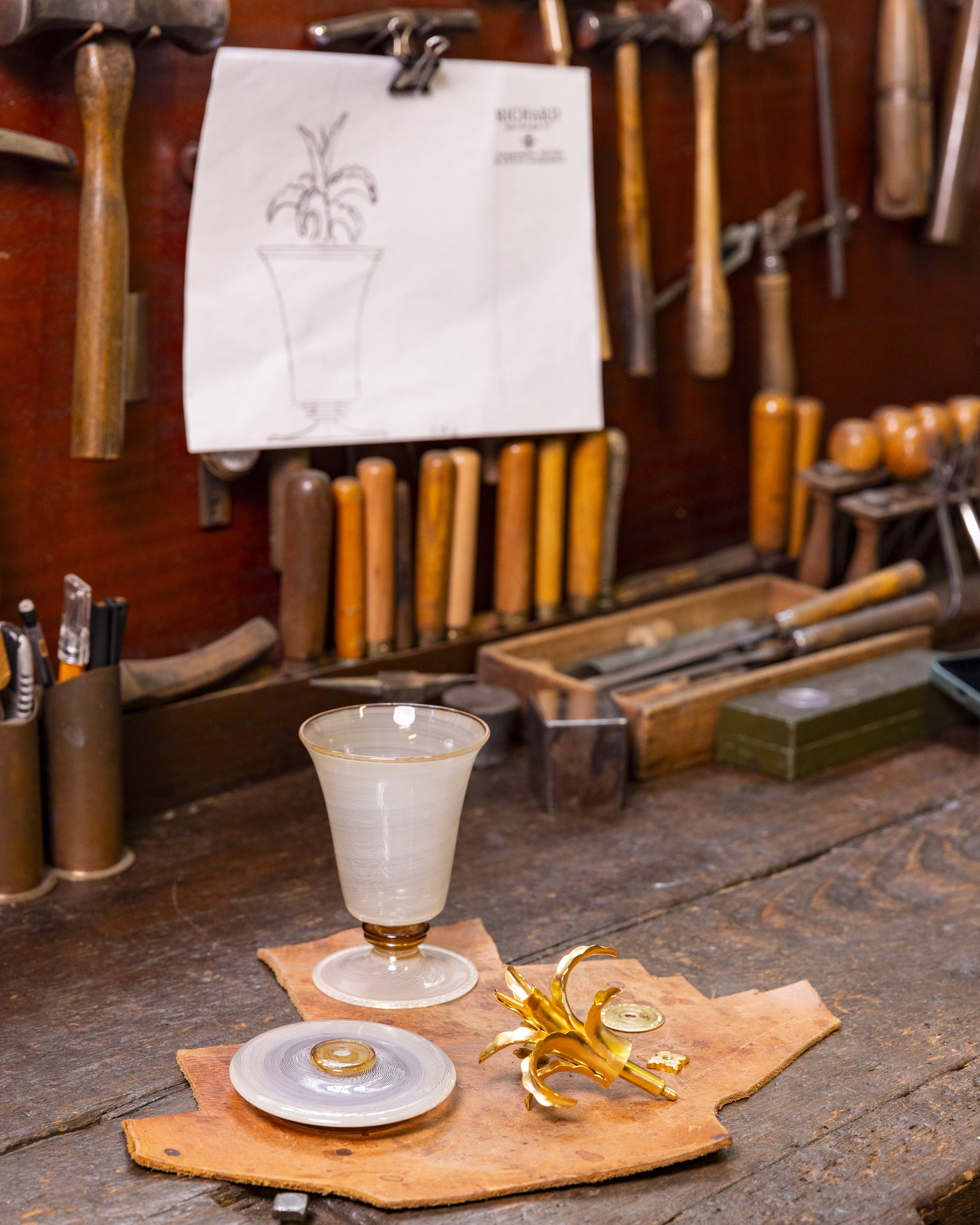
Venetian Alchemy
Two years after presenting his "Venetian Torches" at Homo Faber (Venice), master goldsmith Jean-Pierre Cottet-Dubreuil unveils "Venetian Alchemy" for the new edition of the flagship event of contemporary crafts. Through this collection of 5 unique stamped pieces, Richard Orfèvre, the master goldsmith affirms his talent as a creator and renews his admiration for the art of Murano glassmaking.

With "Flambeaux Vénitiens" and their suite "Alchimie Vénitienne" which combines virtuosities, Jean-Pierre Cottet-Dubreuil frees himself from the rich heritage of Richard Orfèvre to assert his own signature. He thus testifies to a contemporary vision of goldsmithing and illustrates, in the eyes of a clientele of enlightened collectors, Richard Orfèvre's ability to accompany the creation of the most audacious pieces.

This new collection of 3 cups and a pair of candlesticks reiterates the feat of marrying the natural fragility of glass with the solid weight of metal. It also deepens the relationship established with master glassmaker Davide Fuin, whom Jean-Pierre Cottet-Dubreuil asked to illustrate, beyond the technique of filigree glass, that of chalcedony glass, the identity of Murano and just as delicate.
The marbled pieces evoke hard stone. An effect that reinforces the materiality of the new creations and is a nod to the German goldsmiths of Augsburg, famous in the 17th century for the manufacture of sumptuous cups, as spectacular as they are composite. A direct inspiration for the three cups of "Venetian Alchemy" that translate into a contemporary aesthetic the splendor of these objects intended to be exhibited in the "rooms of wonders" and cabinets of curiosities of the princes of the time.

Declaration of love to Murano glass art
Over the course of his many trips to Venice, Jean-Pierre Cottet-Dubreuil developed a real admiration for Murano glass art. Nourished by reading and museum visits, it settled on 18th century torches that he reinterpreted and dressed in vermeil. An almost unnatural association given the different properties of the two materials, and one for which the history of art knows few, if any, precedents.

To make it, it was first necessary to meet Davide Fuin, one of the last Murano maestros capable of working at this level of finesse in the technique of mouth-blown filigree glass. The rest was a matter of talent, determination and time: no less than 160 hours to complete each of the first three pairs of torches presented at the 2022 edition of Homo Faber.

Hatching of a mysterious and captivating nature
If formally the cups of this collection reflect this inspiration of the Renaissance, their vegetal ornamentation owes much to the work of the Venetian designer Napoleone Martinuzzi (1892-1977). A particularly sensitive reference in the development in the form of agave leaves of the "Succulent" cups, which becomes more
diffused on the cup and the pair of “Pavot” torches.
The blossoming of a mysterious nature nonetheless remains the common thread of this collection, which as a whole composes a precious and captivating landscape.
"I imagined plants that were more or less disturbing, more or less fantasized."

Unique pieces of original design
Jean-Pierre Cottet-Dubreuil's creative process begins with an interaction with the glassmaker, to whom he provides the design of the pieces for which he specifies the expected textures and colors.
Once the glass objects have been delivered, the precious metal decoration, previously only sketched, specifies its volumes. Before being shaped, the volumes of the decorations are modeled using plasticine or wax sheets. Then, they will be cut, shaped, chiseled and adjusted to the glass. Once manufactured, the decorations are polished then gilded to transform the silver into vermeil.
This is followed by a burnishing with agate where, more than the shine, the goldsmith seeks to play with matte effects with a contemporary finish.

For the “Pavot” candlestick collection, the vermeil leaves contrast with oxidized silver poppy heads. Each element is entirely handmade and requires several hours of work. The manufacture of other decorations requires the use of a thick silver leaf. The mastery of the goldsmith consists in domesticating this material, stamping it, chiseling it to specify the desired design.
However, the craftsman's greatest feat is also the least perceptible. As a specialist, Jean-Pierre Cottet-Dubreuil has worked on an assembly with ingenious and invisible mechanics, which anticipates the possibility of future restorations. The sign of a know-how that borders on perfection.

Since 1910 and its creation, five generations of goldsmiths have forged the identity and reputation of the RICHARD Orfèvre workshop.
Today, Jean-Pierre Cottet-Dubreuil continues to keep alive the soul of the workshop nestled in the back of a charming backyard in the 3rd arrondissement of Paris.
At the head of the workshop and its exceptional heritage since 2012, he puts all his passion and know-how into creating classic and contemporary collections dedicated to individuals and professionals alike.
